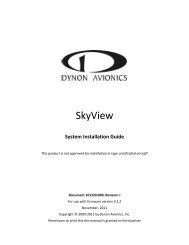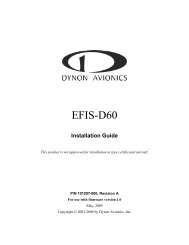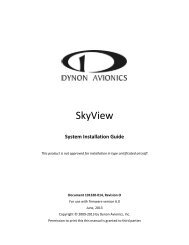EFIS-D100 Installation Guide - Dynon Avionics
EFIS-D100 Installation Guide - Dynon Avionics
EFIS-D100 Installation Guide - Dynon Avionics
Create successful ePaper yourself
Turn your PDF publications into a flip-book with our unique Google optimized e-Paper software.
Autopilot <strong>Installation</strong> and Configuration<br />
Detailed instructions for performing firmware upgrades are contained in the “Help” function of<br />
the <strong>Dynon</strong> <strong>Avionics</strong> Product Support Program which is available on the <strong>Dynon</strong> <strong>Avionics</strong> web<br />
site at downloads.dynonavionics.com.<br />
If you are using a GPS connected to your <strong>Dynon</strong> <strong>EFIS</strong> and will be using GPS as an input<br />
for the AP, please upgrade your GPS to the most current firmware available for it.<br />
<strong>Dynon</strong>’s testing has revealed certain incompatibilities with older versions of GPS<br />
firmware that are corrected with current GPS firmware. Procedures for GPS firmware<br />
upgrades vary by manufacturer; consult your GPS manual for the firmware upgrade<br />
procedure. Additionally, some GPS units must be configured with specific settings to<br />
work properly with <strong>Dynon</strong>’s instruments. More detail on compatibility with, and settings<br />
for various GPS units is available on the <strong>Dynon</strong> <strong>Avionics</strong> web site at<br />
wiki.dynonavionics.com.<br />
AP Servo Configuration<br />
This section guides the installer through all the steps necessary to install, configure, and tune the<br />
Autopilot software on the <strong>EFIS</strong>/servo system. The AP operation functions dealt with here are<br />
primarily focused on configuration and tuning. Pilots should consult the <strong>EFIS</strong>-<strong>D100</strong> Pilot’s User<br />
<strong>Guide</strong> for a comprehensive description of AP operation.<br />
Note: Before proceeding, verify that power is ON for all <strong>EFIS</strong>, EMS, HS34, AP74 and servo(s).<br />
Note: If your system has more than one <strong>Dynon</strong> <strong>EFIS</strong> (that communicates over DSAB), the<br />
configuration of most AP functions can only be performed from the <strong>EFIS</strong> configured as the<br />
DSAB Bus Master (see Network Concepts on page 5-1).<br />
CONFIGURATION OVERVIEW<br />
1. Configure DSAB (required to be performed on the ground)<br />
2. Servo Calibration & Initial Servo Test (required to be performed on the ground)<br />
3. Roll Servo Initial Setup (recommended to be performed on the ground)<br />
4. Pitch Servo Initial Setup (recommended to be performed on the ground)<br />
5. Disengage/CWS Button Configuration (recommended to be performed on the ground)<br />
6. Audio Alerts Configuration (recommended to be performed on the ground)<br />
7. Prepare for Flight Test (recommended to be performed on the ground)<br />
8. Roll Servo Flight Calibration (recommended to be performed in flight under safe<br />
conditions)<br />
9. Pitch Servo Flight Calibration (recommended to be performed in flight under safe<br />
conditions)<br />
STEP 1 - CONFIGURE DSAB<br />
This step sets up the DSAB network so that the <strong>EFIS</strong> can communicate with the servo(s),<br />
optional AP74, and any other <strong>Dynon</strong> products on the DSAB network.<br />
As a safety precaution, while the Configure DSAB procedure is being performed, AP<br />
functionality is disabled.<br />
On the <strong>EFIS</strong>, perform the following:<br />
6-14 <strong>EFIS</strong>-<strong>D100</strong> <strong>Installation</strong> <strong>Guide</strong>
















